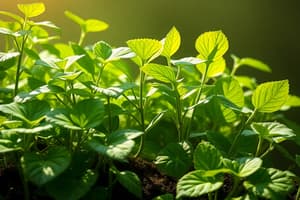Podcast
Questions and Answers
Which of these is NOT a factor affecting the rate of photosynthesis?
Which of these is NOT a factor affecting the rate of photosynthesis?
- Carbon dioxide concentration
- Temperature
- Humidity (correct)
- Light intensity
Proteins are digested into glucose by proteases.
Proteins are digested into glucose by proteases.
False (B)
What is the name of the process that moves food through the digestive system?
What is the name of the process that moves food through the digestive system?
Peristalsis
The small intestine is adapted for absorption with structures called ______
The small intestine is adapted for absorption with structures called ______
Match the following digestive enzymes with the substances they break down:
Match the following digestive enzymes with the substances they break down:
Which of these mineral ions is essential for the production of chlorophyll?
Which of these mineral ions is essential for the production of chlorophyll?
A balanced diet should include carbohydrates, proteins, lipids, vitamins, minerals, water, and dietary fiber in equal proportions.
A balanced diet should include carbohydrates, proteins, lipids, vitamins, minerals, water, and dietary fiber in equal proportions.
Name two functions of bile in the digestive system.
Name two functions of bile in the digestive system.
Flashcards
Photosynthesis
Photosynthesis
The process by which plants convert light energy into chemical energy (glucose).
Word Equation for Photosynthesis
Word Equation for Photosynthesis
Carbon dioxide + Water + Light energy → Glucose + Oxygen.
Factors Affecting Photosynthesis Rate
Factors Affecting Photosynthesis Rate
Light intensity, carbon dioxide concentration, and temperature influence photosynthesis speed.
Chlorophyll's Function
Chlorophyll's Function
Signup and view all the flashcards
Balanced Diet Components
Balanced Diet Components
Signup and view all the flashcards
Role of Digestive Enzymes
Role of Digestive Enzymes
Signup and view all the flashcards
Structure of the Alimentary Canal
Structure of the Alimentary Canal
Signup and view all the flashcards
Function of Bile
Function of Bile
Signup and view all the flashcards
Study Notes
Nutrition: Flowering Plants
- Photosynthesis converts light energy to chemical energy
- Word equation and balanced chemical symbol equation for photosynthesis are understood
- Photosynthesis rate is affected by carbon dioxide concentration, light intensity, and temperature
- Leaf structure is adapted for photosynthesis
- Plants need mineral ions for growth (magnesium for chlorophyll, nitrate for amino acids)
- Practical investigations should show oxygen production, starch production, and light, carbon dioxide, and chlorophyll's role in photosynthesis
Nutrition: Humans
- Balanced diet includes carbohydrates, proteins, lipids, vitamins, minerals, water, and fiber
- Sources and functions of carbohydrate, protein, lipids (fats/oils), vitamins A, C, and D, calcium, iron, water, and fiber are understood
- Energy requirements vary with activity, age, and pregnancy
- Digestive system structures (mouth, esophagus, stomach, small intestine, large intestine, pancreas, duodenum, ileum, colon, rectum) and functions are described
- Peristalsis moves food through the gut
- Digestive enzymes (amylase, maltase, proteases, lipases) break down starch, proteins, and lipids
- Bile is produced by the liver, stored in the gallbladder, neutralizes stomach acid and emulsifies lipids
- Small intestine is adapted for absorption (villi structure)
Studying That Suits You
Use AI to generate personalized quizzes and flashcards to suit your learning preferences.




